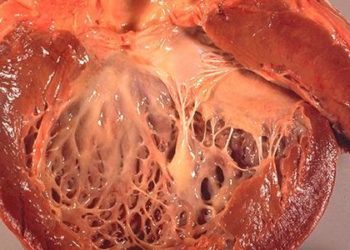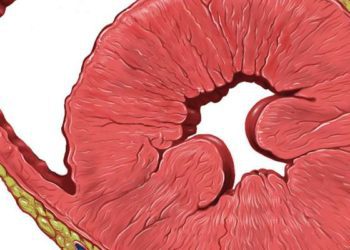MYBPC3 haploinsufficiency results in hypertrophic cardiomyopathy by altering myosin head configurations [PreClinical]
1. Truncating mutations in cardiac myosin-binding protein C (MYBPC3) are a common genetic cause of hypertrophic cardiomyopathy.
2. Haploinsufficiency of MYBPC3 results in cardiomyocyte hypercontractility and impaired relaxation by altering dynamic myosin configurations.
Evidence Rating Level: 2 [Good]
Study Rundown: Hypertrophic cardiomyopathy (HCM) is a disease that causes thickening of the heart muscle as a consequence of genetic mutations. These mutations predominate in genes that encode components of the sarcomere, the contractile apparatus of the cardiomyocyte. Truncating mutations in MYBPC3 (encoding a cardiac myosin-binding protein) are a common cause of HCM. These mutations result in hyperdynamic contraction and impaired relaxation of the heart muscle. Toepfer et al interrogate the effects of MYBPC3 truncating mutations in cardiomyocytes in vitro and in vivo in mouse and in mutant human myocardial tissue. They demonstrate that haploinsufficiency of MYBPC3 results hypercontractile cardiomyocytes. They further demonstrate that this hypercontractile phenotype is associated with a shift of the dynamic conformation of myosin heads to favor states associated with ATPase activity and disfavor states associated with energy conservation. Repressing the function of the myosin’s motor function, with genetic perturbations of the myosin head or with MYK-461, a pharmacologic inhibitor of the myosin ATPase, restored the proportion of myosin heads in energy-conserving states and alleviated the hypercontractile phenotype of MYBPC3-deficient cardiomyocytes. These preclinical data suggest that therapeutic strategies to inhibit myosin with the pharmacologic inhibitor MYK-461 may benefit patients with HCM due to MYBPC3 mutations, while strategies to attenuate MYBPC3 activity might rescue cardiac function in patients with depressed cardiac contractility. The in vivo activity of pharmacologic approaches will need to be evaluated in future studies.
Click here to read the study in Science Translational Medicine
Relevant Reading: Genetics and molecular mechanisms of cardiomyopathy
In-Depth [pre-clinical study]: The objective of this study was to model the abnormalities in contraction and relaxation observed in patients with MYBPC3 truncations at the cellular level. Mice carrying heterozygote truncations of Mybpc3 and mice in which Mybpc3 had been depleted with RNAi were studied. In vivo, Mybpc3t/+, Mybpc3t/t, and Mybpc-RNAi-depleted mice did not exhibit hypercontractile cardiac function or very prominent cardiac hypertrophy. However, cellular studies, in which individual cardiomyocytes were isolated from Mybpc3 mutant mice, revealed hypercontractility and impaired relaxation. This discordance between the in vivo and in vitro effect on contractility was attributed to potential compensatory mechanisms that potentially mask the effect of Mybpc3 haploinsufficiency on the individual cardiomyocyte in vivo, though these mechanisms remain to be determined.
After establishing a contractile phenotype in cardiomyocytes with decreased Mybpc3 protein in vitro, the authors sought to assess the effect of Mybpc3 truncations on myosin conformations. Prior structural analyses predicted that there are two relaxed conformations of paired myosin molecules denoted as the disordered relaxed state (DRX), in which one myosin head is inhibited, and superrelaxed state (SRX), in which both myosin heads are inhibited. Myosin heads in the DRX conformation have ~5X more ATPase activity than myosin heads in the SRX configuration, and thus the fraction of myosin heads in the SRX and DRX configuration can be estimated in a Mant-ATP assay. In this assay, the fraction of heads in the SRX versus DRX state is estimated by perfusing skinned myocardial fibers with fluorescent Mant-ATP, and monitoring its rapid (DRX) or slow (SRX) release. Myocardium from mice depleted of cMyBPC and human myectomy samples from 3 patients with distinct heterozygous truncating mutations in MYBPC3 were employed in Mant-ATP experiments, which revealed a decreased SRX:DRX ratio in the context of MYBPC3 truncations, correctable with a MYK-461, a myosin-ATPase inhibitor, which also normalized contractile function. RNAi depletion of Mybpc in mice engineered to carry a rare human MYH7 variant that causes DCM resulted in increased contractile function and improved proportions of myosins in SRX and DRX.
Image: PD
©2019 2 Minute Medicine, Inc. All rights reserved. No works may be reproduced without expressed written consent from 2 Minute Medicine, Inc. Inquire about licensing here. No article should be construed as medical advice and is not intended as such by the authors or by 2 Minute Medicine, Inc.







